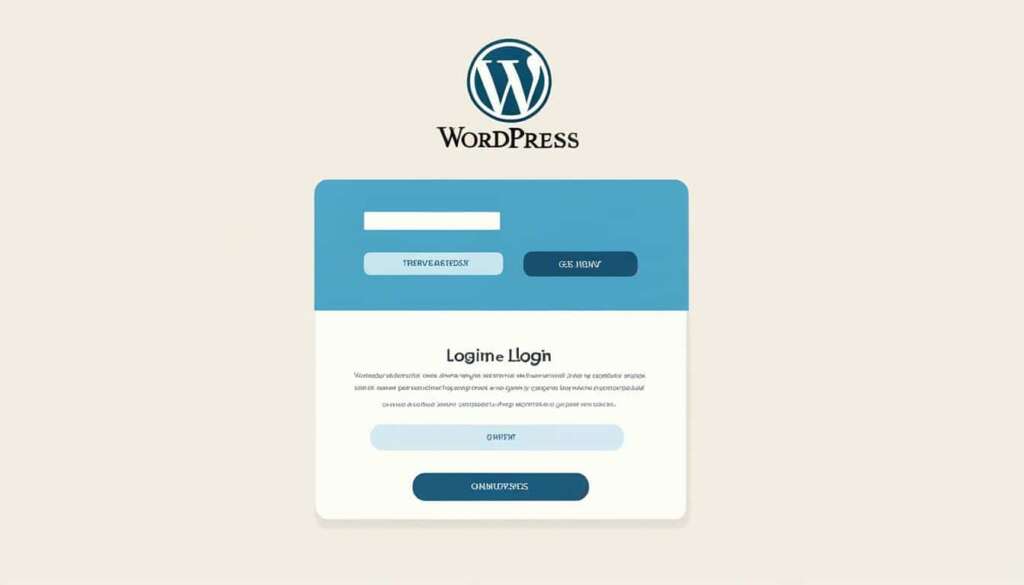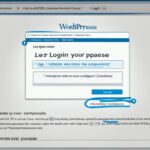Table of Contents
Welcome to our comprehensive guide on how to log into WordPress. In this article, we will walk you through the login process and provide step-by-step instructions on accessing the WordPress login page. Whether you’re a beginner or experienced user, mastering the WordPress login process is essential for managing your website effectively.
Logging into WordPress is the first step towards accessing your website’s dashboard and making any necessary updates or changes. By following our easy-to-understand instructions, you’ll be able to access your WordPress site quickly and efficiently.
If you’re ready to learn how to log into WordPress, let’s get started with the login process and find the WordPress login page.
Key Takeaways
- Understanding the login process is crucial for managing your WordPress site effectively.
- Logging into WordPress grants you access to the website’s dashboard where you can make updates and changes.
- Our step-by-step guide will help you locate the WordPress login page and enter your login credentials securely.
- Stay tuned for troubleshooting tips, two-factor authentication setup, and suggestions to enhance your WordPress login security.
Now, let’s move on to the next section and discover how to locate the WordPress login page.
Locating the WordPress Login Page
Before you can log into WordPress, you need to locate the login page. The WordPress login page is also known as the admin login or dashboard login. Here’s how you can find it:
- Open your web browser and enter your website’s URL in the address bar.
- After the URL, add “/wp-admin” or “/wp-login.php” to the end. For example, if your website is “www.mywebsite.com,” the login page URL would be “www.mywebsite.com/wp-admin” or “www.mywebsite.com/wp-login.php”.
- Press Enter or Return on your keyboard, and you will be redirected to the WordPress login page.
Alternatively, you can search for the login page by entering “WordPress login” or “WordPress admin login” in the search engine. The search results will usually include a direct link to the login page.
Once you have found the login page, bookmark it for easy access in the future. This will save you time when you need to log in to your WordPress dashboard.
Pro Tip: To quickly access the WordPress login page, you can also type “/login” after your website’s URL. For example, “www.mywebsite.com/login”. This method may vary depending on your website’s settings and plugins.
Now that you know how to locate the WordPress login page, you’re ready to proceed to the next step in the login process.
Example of a WordPress Login Page:
| Website | URL |
|---|---|
| WordPress.org | https://wordpress.org/wp-login.php |
| MyWebsite.com | https://www.mywebsite.com/wp-login.php |
| BlogName.com | https://blogname.com/wp-login.php |
Entering Your Username and Password
Once you have found the WordPress login page, it’s time to enter your username and password. This step is crucial as it verifies your credentials and grants you access to your WordPress account.
To input your login credentials correctly and securely, follow these steps:
- Locate the Username field on the login page.
- Enter your registered username. Make sure to type it accurately, paying attention to capitalization and any special characters.
- Move to the Password field, which should be adjacent to the Username field.
- Carefully input your password. Remember that passwords are case-sensitive, so ensure you use the correct capitalization.
- Double-check your entries to ensure accuracy. Ensuring you have entered the correct username and password is crucial for a successful login.
It’s essential to note that passwords should be strong and unique to enhance the security of your WordPress account. Avoid using common passwords or personal information that can be easily guessed. Instead, opt for a combination of uppercase and lowercase letters, numbers, and special characters.
When you’re ready, click on the “Log In” button to proceed with the login process.
Remember, it’s important to keep your login credentials confidential and avoid sharing them with anyone. Sharing your username and password increases the risk of unauthorized access to your WordPress account, potentially compromising your website’s security.
Troubleshooting Login Issues
Sometimes, you may encounter login problems when accessing your WordPress account. These can range from forgetting your password to encountering error messages. In this section, we will provide helpful troubleshooting tips to resolve common login issues and ensure a smooth login experience.
Forgot Password
- If you have forgotten your password, click on the ‘Forgot password’ link on the login page.
- Enter the email associated with your WordPress account.
- You will receive an email with instructions on how to reset your password.
- Follow the instructions in the email to set a new password and regain access to your account.
Error Messages
Error messages can occur due to various reasons, such as incorrect login credentials or compatibility issues. Here are some steps to troubleshoot common error messages:
“Invalid username or password.”
- Double-check the spelling of your username and ensure the correct capitalization.
- Ensure that the password is entered correctly, taking note of any uppercase or lowercase characters.
- If you are still unable to log in, try resetting your password using the ‘Forgot password’ option.
“The page cannot be displayed.”
- Check your internet connection to ensure it is stable.
- Clear your browser cache and cookies.
- Try accessing the WordPress login page using a different browser or device.

| Login Problem | Troubleshooting Tip |
|---|---|
| Forgot Password | Reset your password through the ‘Forgot password’ option. |
| Invalid username or password | Double-check login credentials and reset password if necessary. |
| The page cannot be displayed | Check internet connection, clear cache and cookies, try different browser or device. |
Two-Factor Authentication for Added Security
Enhance the security of your WordPress login with two-factor authentication (2FA). Implementing this additional layer of protection adds an extra step to the login process, ensuring that only authorized users can access your account. In this section, we will explain what two-factor authentication is and guide you on how to set it up for your WordPress login.
What is Two-Factor Authentication?
Two-factor authentication (2FA) is a security measure that requires users to provide two different types of identification before accessing their accounts. Typically, it involves a combination of something you know (like a password) and something you have (like a unique verification code sent to your mobile device).
By promoting the use of two-factor authentication, website owners can significantly enhance the security of their login system.
Setting Up Two-Factor Authentication in WordPress
To enable two-factor authentication for your WordPress login, follow these steps:
- Install and activate a 2FA plugin from the WordPress plugins repository.
- Configure the plugin settings to select the desired 2FA method, such as SMS codes, email verification, or authenticator apps.
- Generate a backup code or set up alternate login methods in case you lose access to your primary 2FA device.
- Save the changes and test the login process to ensure that the two-factor authentication is working correctly.
Remember to choose 2FA methods that are convenient for you but still provide a high level of security. Additionally, regularly review your 2FA settings and update them as needed to maintain a secure login environment.
By implementing two-factor authentication, you significantly reduce the risk of unauthorized access to your WordPress account. This additional layer of security adds an extra hurdle for potential attackers, making it harder for them to infiltrate your login system.
| Benefits of Two-Factor Authentication | Methods of Two-Factor Authentication |
|---|---|
|
|
Implement two-factor authentication for your WordPress login today to safeguard your account from unauthorized access and enhance its overall security.
Remember Me and Browser Security
WordPress offers a “Remember Me” option that allows you to conveniently stay logged in for future sessions. This feature can be especially useful if you’re the sole user of your device and want to save time when accessing your WordPress site.
However, it’s important to note that enabling the “Remember Me” option can introduce potential security risks. A compromised device or browser can grant unauthorized access to your WordPress account, jeopardizing the confidentiality of your sensitive information.
To mitigate these risks, it’s crucial to prioritize browser security. Keep your browser up to date with the latest security patches and ensure you have a robust antivirus software installed. Regularly clear your browser cache and cookies to remove any stored login information that may pose a security threat.
When using the “Remember Me” option, exercise caution, especially when using a shared or public device. Always remember to log out of your WordPress account after each session, even if the “Remember Me” option is enabled.
Automatic Login
Automatic login, which is often associated with the “Remember Me” option, provides the convenience of effortless access to your WordPress site. However, it’s essential to evaluate whether the benefits outweigh the potential security risks.
Consider your unique circumstances and the sensitivity of the information stored within your WordPress account. If you’re working on a public computer or sharing your device with others, automatic login may not be the best choice for maintaining the security of your account.
“Remember Me” and automatic login provide convenience, but it’s important to make informed decisions about your account security. Prioritize browser security and exercise caution when using these features.
By carefully considering the risks and implementing appropriate security measures, you can make the most of the “Remember Me” option without compromising your WordPress login credentials. Remember, the security of your website and data is paramount, and taking steps to protect it is always a wise decision.
Logging out of WordPress
When you’re finished working on your WordPress site, it’s essential to log out properly to ensure the security of your account. Logging out not only ends your current session but also protects your site from unauthorized access.
To log out of WordPress, follow these simple steps:
- Locate the “Logout” button or link. Usually, you’ll find it in the upper right corner of the WordPress admin dashboard or toolbar.
- Click on the “Logout” button/link. This action will end your session and log you out of WordPress.
Remember, logging out closes the current session and prevents anyone from accessing your account without authorization. Always log out of WordPress, especially when using a shared or public computer.
By logging out, you ensure that your session ended, protecting sensitive data and preventing others from making unauthorized changes to your site. Practicing secure logout practices is crucial for maintaining the integrity of your WordPress account.
For added security, consider clearing your browsing history and cache after logging out.
Secure Logout Best Practices
To strengthen the security of your WordPress logout process, follow these best practices:
- Always log out after each session, even if you’re the only one accessing your WordPress site.
- Don’t rely solely on the “Remember Me” option, as it leaves your session open and vulnerable to exploitation.
- Avoid logging in to your WordPress account on public or shared devices.
- Regularly review your WordPress session and activity logs for any suspicious activity.
- Consider enabling a two-factor authentication plugin to add an extra layer of security when logging in.
Following these secure logout practices will help safeguard your WordPress site and protect your valuable content and data from unauthorized access.
| Benefits of Secure Logout | Consequences of Neglecting Secure Logout |
|---|---|
|
|
Conclusion
Logging into WordPress is a straightforward process that involves finding the login page and entering your username and password. By following the steps outlined in this guide, you can easily and securely access your WordPress account.
It’s important to prioritize the security of your WordPress login. Consider implementing additional measures such as enabling two-factor authentication. This adds an extra layer of protection to your account and safeguards against unauthorized access.
Furthermore, practicing proper logout procedures is crucial. When you’re finished working on your WordPress site, make sure to log out to ensure the integrity of your account. By following these best practices, you can maintain the optimal security of your WordPress login.
FAQ
How do I log into WordPress?
To log into WordPress, you need to follow a few simple steps. First, locate the WordPress login page, also known as the admin login or dashboard login. Once you’ve found the login page, enter your username and password in the designated fields. Finally, click on the login button to access your WordPress dashboard.
Where can I find the WordPress login page?
The WordPress login page can be found by appending “/wp-admin” to the end of your website’s URL. For example, if your website URL is “www.yourwebsite.com,” you can access the login page by typing “www.yourwebsite.com/wp-admin” into your web browser’s address bar.
How do I enter my username and password?
Once you’ve reached the WordPress login page, you will see fields to enter your username and password. Carefully input your correct username and password in the respective fields. It’s important to double-check the spelling and ensure that the correct case is used for both the username and password.
What should I do if I encounter login issues?
If you are experiencing login issues, there are a few troubleshooting steps you can take. First, make sure you are entering the correct username and password. If you’ve forgotten your password, you can use the “Forgot Password” option to reset it. Additionally, if you encounter error messages during login, try clearing your browser cache and cookies or using a different web browser.
What is two-factor authentication, and how can I set it up for my WordPress login?
Two-factor authentication (2FA) is an added security measure that requires you to provide a secondary verification method, such as a code sent to your phone, after entering your username and password. To set up 2FA for your WordPress login, you can use a plugin like “Two-Factor” or “Google Authenticator.” These plugins will guide you through the process of enabling 2FA and provide you with the necessary instructions.
Should I use the “Remember Me” option for automatic login?
While the “Remember Me” option can be convenient for automatic login, it is important to consider browser security. Using this option on public or shared computers can pose a security risk. It’s best to use the “Remember Me” option only on trusted devices or personal computers to ensure the safety of your WordPress account.
How do I log out of WordPress?
To log out of WordPress, go to the WordPress admin dashboard and locate the “Logout” button. Click on the “Logout” button, and your session will be ended, ensuring the security of your account. It is essential to practice secure logout procedures, especially when using public or shared computers.












